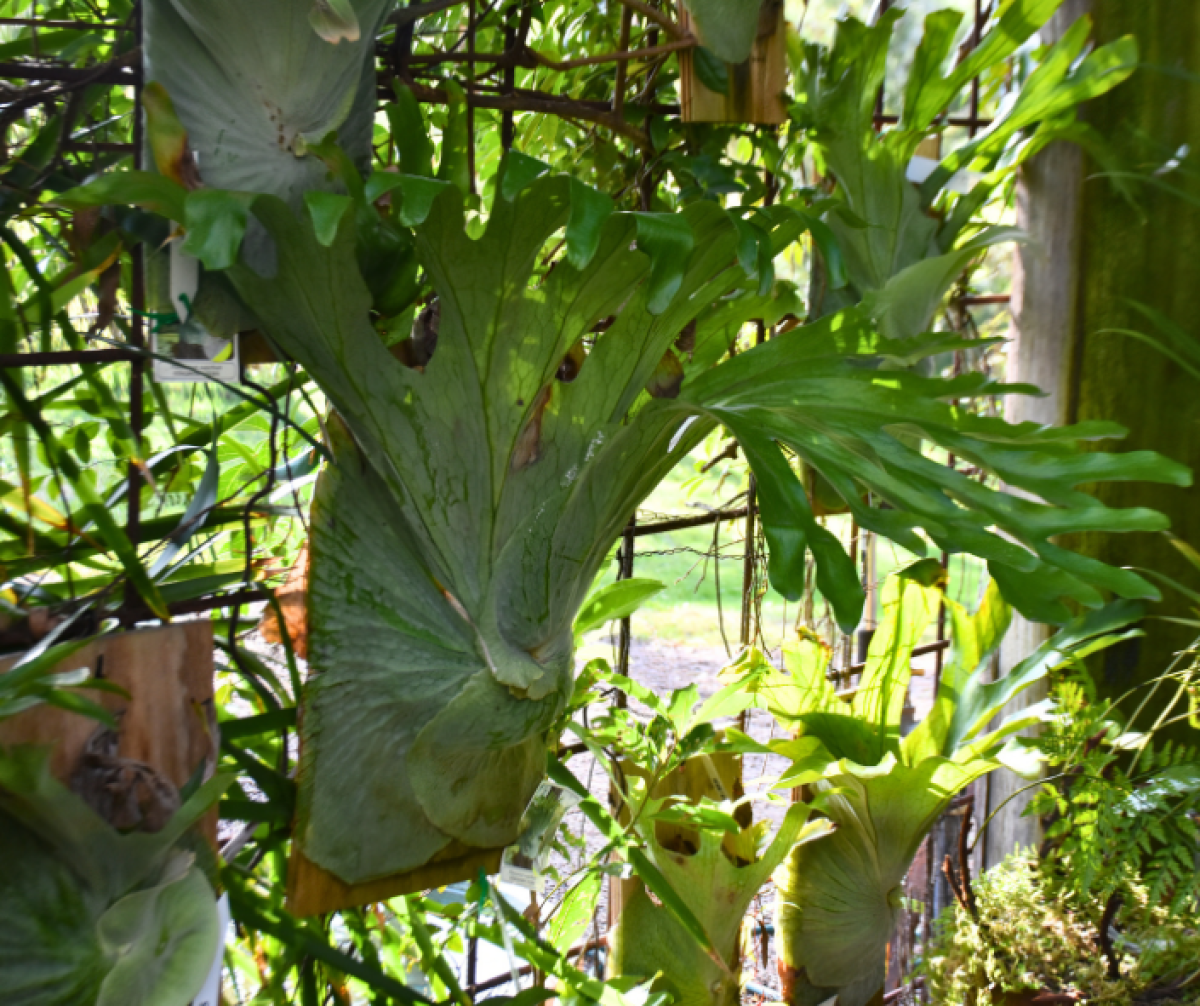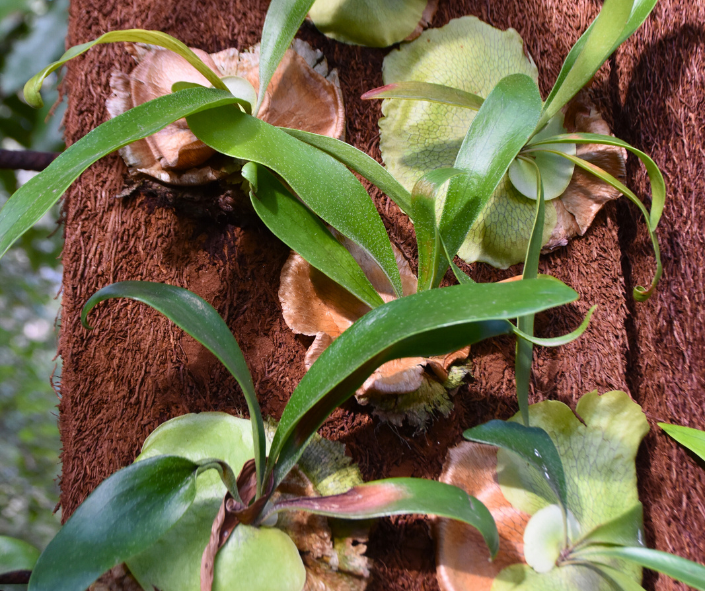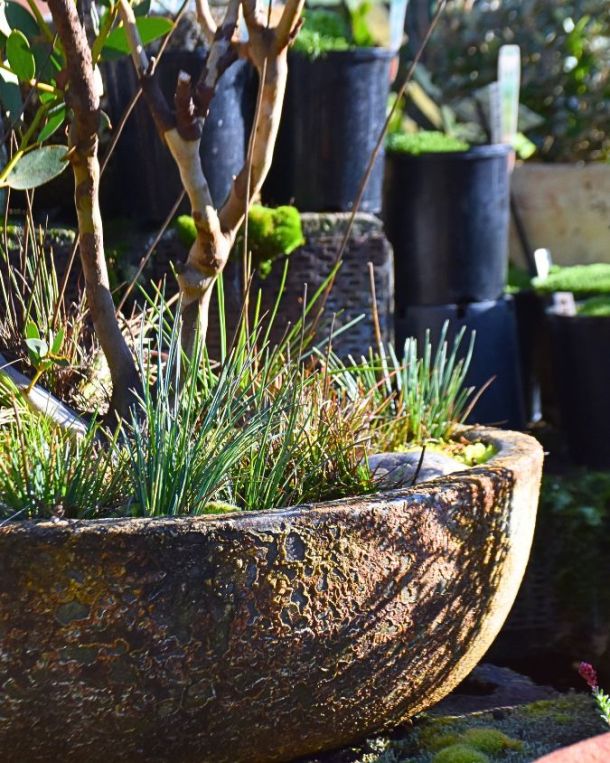The Complete Guide to Growing Stag and Elk Horn Ferns: Australia’s Magnificent Epiphytes

Have you ever admired those spectacular ferns growing on tree trunks in the rainforest? Australia is home to four remarkable species of stag and elk horn ferns, and they can bring that same natural beauty to your own garden. These magnificent epiphytes have been captivating Australian gardeners for generations, and with the right knowledge, you can successfully grow these living sculptures at home.
Meet Australia’s Native Stag and Elk Horn Ferns
Australia boasts four native species of these extraordinary ferns:
- Platycerium bifurcatum (Elk Horn Fern) – the most common and garden-friendly
- Platycerium superbum (Stag Horn Fern) – the giant of the family
- Platycerium hillii (Northern Elk Horn) – a rare northern beauty, not generally available in nurseries.
- Platycerium veitchii (Silver Elk Horn) – rare prized possession for its silvery foliage
While all four are stunning, the Elk Horn and Stag Horn ferns are the stars of home cultivation, offering gardeners the best chance of success.
The Elk Horn Fern: Your Gateway to Epiphyte Gardening

Understanding the Elk Horn Fern (Platycerium bifurcatum)
The Elk Horn Fern is nature’s perfect starter epiphyte. Found naturally along Queensland and New South Wales’ east coast, this adaptable species grows both on trees (as an epiphyte) and on rocks (as a lithophyte). In the wild, you’ll find them creating impressive colonies on tree trunks and rough rock faces throughout rainforests and open forests.
What makes Elk Horn Ferns particularly fascinating is their incredible longevity and growth pattern. These plants can literally grow forever, given adequate space and secure attachment. Each year, they produce new plants in a “plant on a plant, on a plant” effect, eventually forming those magnificent clumps you see in nature.
Growing Your Elk Horn Fern Successfully
Mounting Your Fern The secret to success starts with proper mounting. Use weathered hardwood boards, tree fern trunks or slabs, or attach directly onto trees with permanent bark. The key is choosing a stable, long-lasting support that can handle the fern’s eventual impressive size.
Looking for a tree fern trunk, these are available for purchase from Kuranga.
Creating the Perfect Environment Position your Elk Horn Fern where it’s protected from frost and those harsh, hot dry winds that can stress the plant. Filtered or partial sunlight with excellent air circulation creates the ideal growing conditions. Think of recreating that dappled forest light they love in nature.
Watering Wisdom During hot, dry periods, regular watering is essential. However, established plants become surprisingly tolerant of direct sun and drier conditions. The winter months require a lighter touch – keep them slightly dry to prevent the dreaded “nest” leaf rot that can damage your prized fern.
Feeding for Fantastic Growth Regular applications of seaweed emulsions like Seasol or Maxicrop work wonderfully, supplemented with occasional light liquid fertiliser applications. These gentle feeds provide the nutrients your fern needs without overwhelming it.
Propagating Your Elk Horn Fern
One of the joys of Elk Horn Ferns is their natural ability to produce new plants. When you’re ready to expand your collection or share with friends, carefully remove new plants using a small trowel or knife from behind the round green basal leaves. Gently lift the edges while cutting behind, then attach to a new backing board or tree trunk using fishing line or thin wire.
Remember to use minimal sphagnum moss over the board – too much can actually cause problems. Be patient, as the new annual leaves will eventually cover all your securing materials, creating that natural, established look.
The Majestic Stag Horn Fern: A Garden Showstopper

Understanding the Stag Horn Fern (Platycerium superbum)
If Elk Horn Ferns are the friendly introduction to epiphyte growing, Stag Horn Ferns are the grand finale. Found throughout Queensland and New South Wales with a more restricted range, these rainforest epiphytes are true garden aristocrats.
Unlike their Elk Horn cousins, Stag Horn Ferns don’t reproduce vegetatively. Instead, they grow larger each year as magnificent individual specimens, eventually reaching truly massive proportions that become garden focal points.
The Fascinating Leaf Structure
Stag Horn Ferns showcase two distinct types of leaves that work together in perfect harmony. The wide, flat “nest” leaves die off and replace themselves annually, creating a natural nutrient-catching nest effect. The fertile pendulous fronds develop rusty spore patches – don’t worry, these aren’t signs of disease but rather the fern’s natural reproductive process.
Cultivating Your Stag Horn Fern
Mounting and Positioning Use weathered wood and tree fern backing boards for mounting, or in warmer areas, attach directly to tree trunks. Position in frost-free locations with filtered light, adequate humidity, and excellent air circulation.
Looking for a tree fern trunk, these are available for purchase from Kuranga.

Watering Requirements Stag Horn Ferns are remarkably adapted to long dry seasons, requiring minimal watering. During hot weather, once weekly watering is sufficient. Keep them dry during winter to prevent rot and fungal infections – these plants prefer to be slightly thirsty rather than too wet.
Feeding and Care Like Elk Horn Ferns, regular seaweed emulsions (Seasol or Maxicrop) combined with occasional light liquid fertiliser applications (Thrive or Phostrogen) provide optimal nutrition.
Transplanting Tips When your Stag Horn Fern outgrows its mounting, autumn and spring offer the best transplanting opportunities. The cooler temperatures minimise stress during the transition. Move to larger backing boards as required, ensuring large plants are well-secured until roots regrow into the new medium.
Keeping Your Ferns Healthy: Pest Management
Generally, stag and elk horn ferns are remarkably pest-free, but occasionally you might encounter:
Stag Horn Borer: These caterpillar larvae tunnel through nest leaves. Regular Pyrethrum spray applications during active infestations provide effective control.
Stag Horn Beetle: Less severe than borers, these can be manually removed at dusk when they’re most active.
Scale and Mealy Bug: These typically attack stressed plants that are either too wet or too dry. Address the underlying stress factors, and the pest problem usually resolves itself.

Expert Advice for Success
Growing stag and elk horn ferns successfully requires understanding their natural habitat and replicating those conditions in your garden. These magnificent plants reward patience and proper care with decades of spectacular growth.
Visit us at 118 York Road, Mount Evelyn, to see our selection of stag and elk horn ferns and get hands-on advice from our qualified staff. We’ve been helping Australian gardeners succeed with native plants since 1969, and we’d love to help you create your own epiphyte masterpiece.
“The first dental office
I actually like going to.”
Kuranga original content and photos are copyright protected. Please email us before re-posting our
content elsewhere. Thank you!
